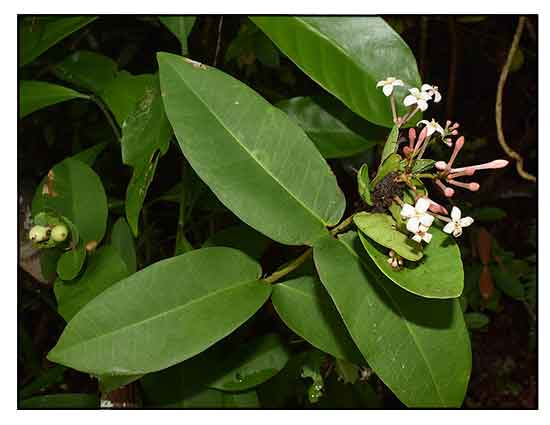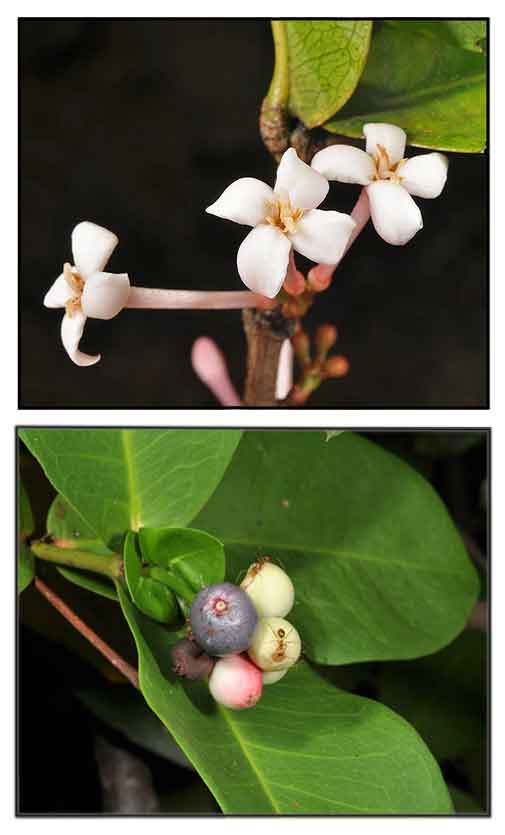
Family • Rubiaceae
Kamingi
Kayomkom
Ixora philippinensis Merr.
PHILIPPINE SANTAN
Xiao xian long chuan hua
| Scientific names | Common names |
| Ixora graciliflora Hayata | Bua-ungit (Pint Sbl.) |
| Ixora hayatae Kaneh. | Gintinanik (Ilk.) |
| Ixora littoralis Merr. | Kayomkom (Tag.) |
| Ixora philippinensis Merr. | Kamingi (Tag.) |
| Pavetta jambosifolia Teijsm. & Binn. | Lulumboi (Kuy.) |
| Lumoi-manok (Pang.) | |
| Makomakopahan (Tag.) | |
| Oon (P. Bis.) | |
| Payuput kayu (Mang.) | |
| Santan gubat (Tag.) | |
| Tagpo-laki (Ati-Negrito) | |
| Talapulukit (Mag.) | |
| Tintinani (Ilk.) | |
| Tulang-tulang (Ilk.) | |
| Uun (C. Bis.) | |
| Udok-udok (Tagb.) | |
| Philippine santan (Engl.) | |
| Ixora philippinensis Merr. is an accepted species. KEW: Plants of the World Online | |
| Kayomkom is a local name shared by Ixora philippinensis and Clerodendrum brachyanthum (Mangha). | |
Botany
Constituents Availability |
December 2023
![]()
 |
PHOTOS / ILLUSTRATIONS |
| IMAGE SOURCE: Rubiaceae : Ixora philippinensis / Leaves and flowers / Copyright © 2017 by P B Pelser & J F Varcelona (contact: [email protected])) [ref. 122938] / Non-Commercial Use / image modified / click on image or link to go to source page / Phytoimages.siu.edu |
| IMAGE SOURCE: Rubiaceae : Ixora philippinensis / Flowers / Copyright © 2017 by P B Pelser & J F Barcelona (contact: [email protected])) [ref. 119509] / Non-Commercial Use / image modified / click on image or link to go to source page / Phytoimages.siu.edu |
| IMAGE SOURCE: Rubiaceae : Ixora philippinensis / Infructescence / Copyright © 2017 by P B Pelser & J F Barcelona (contact: [email protected])) [ref. 121231] / Non-Commercial Use / image modified / click on image or link to go to source page / Phytoimages.siu.edu |
Additional
Sources and Suggested Readings |
DOI: It is not uncommon for links on studies/sources to change. Copying and pasting the information on the search window or using the DOI (if available) will often redirect to the new link page. (Citing and Using a (DOI) Digital Object Identifier) |
| List of Understudied Philippine Medicinal Plants |
| New plant names needed The compilation now numbers over 1,300 medicinal plants. While I believe there are hundreds more that can be added to the collection, they are becoming more difficult to find. If you have a plant to suggest for inclusion, native or introduced, please email the info: scientific name (most helpful), local plant name (if known), any known folkloric medicinal use, and, if possible, a photo. Your help will be greatly appreciated. |
• |
 |

 General info
General info Distribution
Distribution